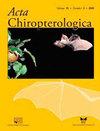Species Composition of Bats in Brazilian Restingas: Testing Environmental Versus Geographical Hypotheses for Community Composition
IF 0.7
4区 生物学
Q4 ZOOLOGY
引用次数: 0
Abstract
Restingas are ecosystems located in the coastal regions of the Atlantic forest, characterized by heterogeneous vegetation of sandy soil. This region has historically come under severe human pressure, and a large portion of these areas have been lost or degraded. The mammalian fauna of restingas is poorly known particularly for bats. This lack of information prevents a better understanding of the biological processes affecting bats and restingas and may severely impair conservation actions. Here we analyze bat species composition, richness, and similarity in 17 restingas sites in Brazil to check whether bat community composition is correlated with geographic distance among sites. We conducted an extensive survey of a published scientific literature to gather data and have a picture of the current knowledge on restinga bats. Until now, 40 bat species are documented in the restingas ecosystems. The richest restinga was in Jurubatiba National Park, and those with the lowest species richness were in Ilha de Cabo Frio, Saquarema, and Barra de Maricá. We found no relationship between geographic distance and dissimilarity on species composition among restingas sites. Although much attention has been paid to sampling this area, it has not been sampled uniformly. In fact, restingas have been undersampled causing a lack of recognition of how important these areas are biologically.巴西Restingas蝙蝠的物种组成:测试环境与地理假设的群落组成
Restingas是位于大西洋森林沿海地区的生态系统,其特征是沙质土壤的异质性植被。历史上,该地区一直承受着严重的人类压力,其中很大一部分地区已经消失或退化。栖息动物的哺乳动物群鲜为人知,尤其是蝙蝠。这种信息的缺乏阻碍了对影响蝙蝠和休息的生物过程的更好理解,并可能严重损害保护行动。本文分析了巴西17个休息点的蝙蝠种类组成、丰富度和相似性,以检验蝙蝠群落组成是否与地点之间的地理距离相关。我们对已发表的科学文献进行了广泛的调查,以收集数据,并对目前关于栖息蝙蝠的知识有一个了解。到目前为止,在该地的生态系统中记录了40种蝙蝠。物种丰富度最丰富的是juruatiba国家公园,物种丰富度最低的是Ilha de Cabo Frio、Saquarema和Barra de maric。地理距离与不同栖地物种组成差异无明显关系。虽然对这一地区的采样已经引起了很大的关注,但采样并不均匀。事实上,这些地区的采样不足,导致人们对这些地区在生物学上的重要性认识不足。
本文章由计算机程序翻译,如有差异,请以英文原文为准。
求助全文
约1分钟内获得全文
求助全文
来源期刊

Acta Chiropterologica
生物-动物学
CiteScore
2.50
自引率
20.00%
发文量
42
审稿时长
>12 weeks
期刊介绍:
Acta Chiropterologica, published by the Museum and Institute of Zoology at the Polish Academy of Sciences, is devoted solely to the study and discussion of bats.
 求助内容:
求助内容: 应助结果提醒方式:
应助结果提醒方式:


